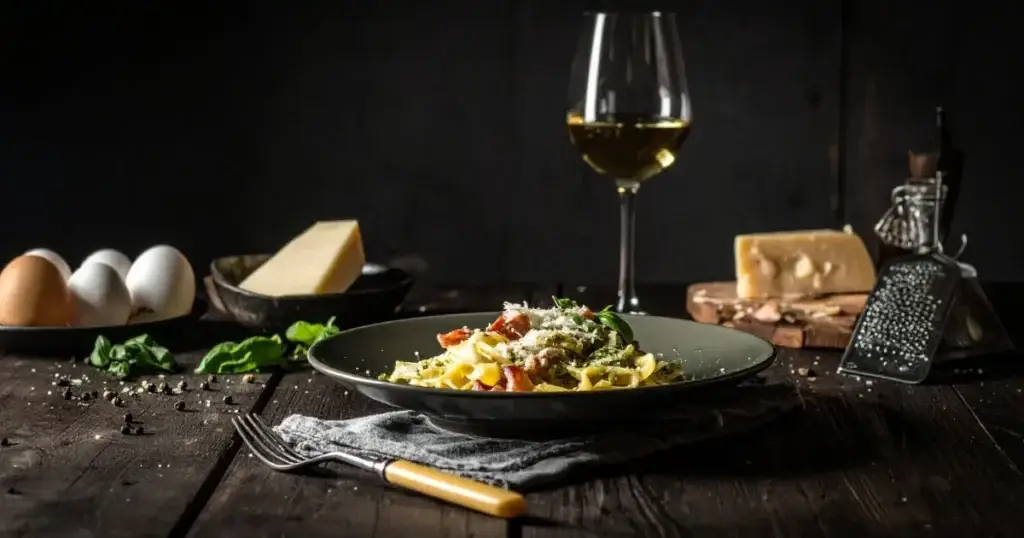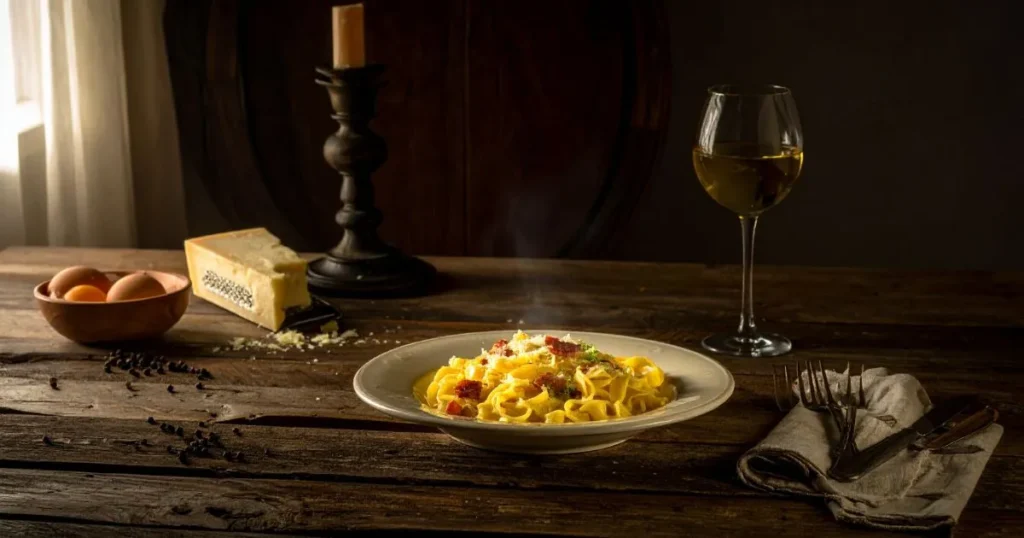Table of Contents
Authentic Spaghetti Carbonara Recipe
Imagine this: you’re standing in a sunlit Roman kitchen, the scent of sizzling guanciale wafting through the air, and a bowl of golden, glossy spaghetti carbonara waiting to be twirled onto your fork. There’s a reason this dish has become a symbol of Italian comfort food—when made the authentic way, it’s a revelation. If you’ve ever wondered how to recreate the true Roman experience at home, you’re about to discover the secrets behind the authentic spaghetti carbonara recipe—no cream, no shortcuts, just pure tradition.
What Makes an Authentic Spaghetti Carbonara Recipe?
Before you reach for your apron, it’s worth understanding what sets the real deal apart from the many imitations. Carbonara’s roots are deeply embedded in Roman culinary history, and its simplicity is its strength.
A Brief History of Carbonara
The origins of carbonara are shrouded in a bit of mystery, but most food historians agree that it’s a relatively modern addition to the Roman repertoire. Some say it was born in the aftermath of World War II, when American soldiers brought bacon and powdered eggs to Italy. Others trace its lineage to the hearty meals of Roman charcoal workers—carbonari—who needed something quick, filling, and flavorful.
Regardless of its exact beginnings, one thing is clear: the authentic spaghetti carbonara recipe is a celebration of just a handful of ingredients, each playing a crucial role.
Key Elements of Authenticity
To make a true Roman carbonara, you need to follow a few non-negotiable rules:
- No cream, no garlic, no onions. The creamy texture comes from eggs and cheese, not dairy.
- Only five essential ingredients: pasta, guanciale, eggs, Pecorino Romano, and black pepper.
- Technique matters: The sauce is created by the gentle heat of the pasta, not by direct cooking.
These principles are backed by Italian culinary authorities like the Accademia Italiana della Cucina, who have codified the traditional recipe to preserve its integrity.
Essential Ingredients for True Roman Carbonara
The beauty of carbonara lies in its simplicity, but that means every ingredient must be top-notch. Here’s what you’ll need for the most authentic spaghetti carbonara recipe.
Ingredient List Table
| Ingredient | Quantity (for 4 servings) | Notes |
|---|---|---|
| Spaghetti | 400g | High-quality, durum wheat |
| Guanciale | 150g | Pork jowl, not pancetta |
| Eggs | 3 large | Use only yolks for richness |
| Pecorino Romano | 80g, finely grated | Sharp, salty sheep’s cheese |
| Black Pepper | To taste | Freshly cracked |
Ingredient Tips and Substitutions
- Guanciale: This cured pork jowl is the soul of carbonara. Its unique fat content and flavor can’t be matched by bacon or pancetta. Should guanciale be unavailable, you can opt for pancetta, though the flavor won’t fully capture the traditional Roman essence.
- Pecorino Romano: This sheep’s milk cheese is sharp, salty, and essential. Parmigiano Reggiano is sometimes used in other pasta dishes, but for carbonara, stick with Pecorino for that true Roman bite.
- Egg Yolks: Using only the yolks gives the sauce its signature silkiness. While certain versions call for a whole egg to achieve a creamier texture, true traditionalists stick exclusively to egg yolks.
- Spaghetti: While spaghetti is the classic choice, you can also use rigatoni or bucatini if you want to mix things up.

Step-by-Step Guide: How to Make Authentic Spaghetti Carbonara (No Cream!)
Ready to bring Rome to your kitchen? By following these instructions, you’ll create a genuine spaghetti carbonara that could win the approval of even the most particular Italian grandmother.
Preparation Steps
- Prep the Ingredients
- Dice the guanciale into small strips or cubes, about 1/4 inch thick.
- Separate the egg yolks into a bowl.
- Finely grate the Pecorino Romano cheese.
- Cook the Pasta
- Bring a large pot of salted water to a rolling boil.
- Add the spaghetti and cook until just al dente, usually 1-2 minutes less than the package instructions.
- Render the Guanciale
- While the pasta cooks, place the guanciale in a cold skillet and set over medium heat.
- Cook slowly, allowing the fat to render and the meat to become crispy and golden. This usually takes about 5-7 minutes.
- Remove from heat and set aside, keeping the rendered fat in the pan.
- Mix the Sauce
- Combine the egg yolks in a mixing bowl with the majority of the grated Pecorino Romano—save a bit for garnish—and add plenty of freshly ground black pepper.
- The mixture should be thick and creamy.
- Combine Everything
- Once your pasta reaches the perfect al dente texture, set aside roughly a cup of the starchy cooking water.
- After draining the spaghetti, quickly transfer it into the pan containing the guanciale and its rendered fat.
- Give everything a thorough toss so the pasta absorbs all the savory richness from the guanciale.
- Remove the skillet from the heat. Quickly pour in the egg and cheese mixture, tossing vigorously to create a creamy sauce. Add a splash of reserved pasta water as needed to achieve a silky, glossy consistency.
- Serve Immediately
- Plate the pasta and top with the remaining Pecorino Romano and more black pepper.
Pro Tips for Perfect Carbonara
- Avoid Scrambled Eggs: The key is to combine the egg mixture with the pasta off the heat. The residual warmth will cook the eggs gently, creating a sauce rather than scrambled eggs.
- Use Pasta Water Wisely: The starchy water helps emulsify the sauce, making it cling to every strand of spaghetti.
- Timing is Everything: Have all your ingredients prepped and ready before you start cooking. Carbonara comes together quickly, and timing is crucial for the perfect texture.

Common Mistakes to Avoid in Spaghetti Carbonara
Even experienced cooks can stumble when making carbonara. Here’s what to watch out for:
- Adding Cream or Milk: Including cream or milk is a frequent misstep; the true creaminess of carbonara comes solely from eggs and cheese.
- Using Bacon or Pancetta Instead of Guanciale: While pancetta is a closer substitute, bacon changes the flavor profile significantly.
- Overcooking the Eggs: If the pan is too hot, you’ll end up with scrambled eggs instead of a smooth sauce.
- Skipping Pecorino Romano: Parmesan is not a substitute here. The sharpness of Pecorino is essential.
- Neglecting Black Pepper: Freshly cracked black pepper is a defining flavor in carbonara. Don’t skimp!
Serving Suggestions and Pairings
You’ve mastered the authentic spaghetti carbonara recipe—now it’s time to serve it like a Roman.
Traditional Roman Side Dishes
- Carciofi alla Romana (Roman-style artichokes): Tender artichokes braised with herbs and olive oil.
- Puntarelle Salad: Crisp chicory shoots with anchovy dressing, a classic Roman starter.
- Saltimbocca alla Romana: Veal cutlets with prosciutto and sage, for a heartier meal.
Wine Pairings
- Frascati: A crisp, dry white wine from the Lazio region, perfect for cutting through the richness of carbonara.
- Verdicchio: Another Italian white with enough acidity to balance the dish.
- Light Reds: If you prefer red wine, try a young Chianti or a light Pinot Noir.
How to Plate Carbonara
- Use warm plates to keep the pasta hot.
- Twirl the spaghetti into neat nests for an elegant presentation.
- Finish with a final dusting of Pecorino Romano and a crack of black pepper.
FAQs About Authentic Spaghetti Carbonara Recipe
Can I use pancetta or bacon instead of guanciale in an authentic spaghetti carbonara recipe?
Guanciale is the traditional choice for its unique flavor and texture. Pancetta is a closer substitute if guanciale isn’t available, but bacon will give a smokier, less authentic taste.
Why is there no cream in the authentic spaghetti carbonara recipe?
The creamy texture comes from the emulsion of egg yolks, cheese, and pasta water. Adding cream is a modern adaptation and not part of the Roman tradition.
Can I use whole eggs instead of just yolks?
A mix of whole eggs and yolks is sometimes used for a lighter consistency, but relying solely on yolks delivers the most luxurious and velvety sauce.
What’s the best pasta shape for authentic carbonara?
Spaghetti is the classic choice, but rigatoni or bucatini are also popular in Rome. The key is to use a shape that holds the sauce well.
How do I prevent the eggs from scrambling?
Take the skillet off the burner before stirring in the egg mixture, and mix briskly—the remaining warmth will gently thicken the sauce without scrambling the eggs.
Conclusion: Bring Rome to Your Table
There’s a special kind of magic in mastering the authentic spaghetti carbonara recipe. By using a few top-notch ingredients and mastering some straightforward steps, you’ll be able to recreate the taste of Rome at home. Whether you’re cooking for family, friends, or just yourself, this dish is sure to impress and satisfy.
So, why not give it a try tonight? Gather your ingredients, follow these steps, and experience the true taste of Roman tradition. And when you do, share your results or favorite tips in the comments below—let’s keep the spirit of authentic Italian cooking alive, one plate of carbonara at a time!
Ready to cook? Bookmark this authentic spaghetti carbonara recipe , share it with your fellow food lovers, and subscribe for more authentic Italian classics. Buon appetito!

